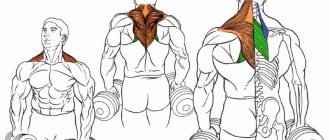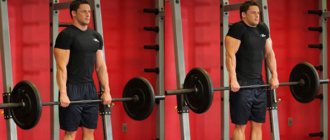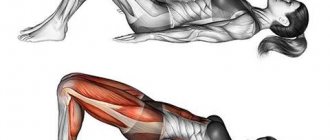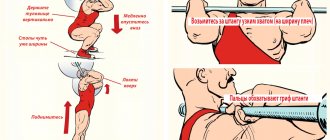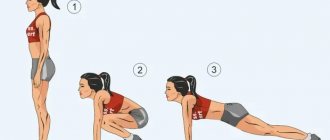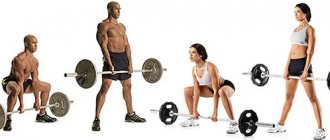Share:
Exercise clusters are a combination of two sequentially performed exercises known in CrossFit: cleans (in any way convenient for you) and thrusters (thrusters with a barbell). After each release, the barbell is placed on the floor, and we begin the next repetition from the original position. During the cluster exercise, almost the muscle groups of our body work: hamstrings, quadriceps, deltoids, spinal extensors, trapezius and abs. For this reason, it has gained immense popularity in CrossFit.
Today we will look at the following aspects of the cluster exercise:
- Technique for performing the exercise;
- CrossFit complexes containing an exercise cluster.
Clusters: video
FST - Functional Strength Training: Cluster Training
Cluster training is one of the most effective methods of increasing strength. Carl Miller popularized it in the 70s with a number of articles in bodybuilding magazines. In traditional strength training, the athlete is asked to use the following load parameters: 5 sets of 5 RM with muscle failure on the last repetition of each set and rest for about four minutes. During cluster training, he performs just 25 reps with weights at 85 percent of 1RM for about 25 minutes. Cluster training involves you selecting a higher percentage of your 1RM and resting longer between reps, such as 10-15 seconds. Instead of doing five sets of 5 reps at 85% of your 5RM, you'll be able to use a weight that's 90% of your 5-rep max. Therefore, cluster training can increase the duration of high-threshold fast-twitch muscle fibers under higher load and creates the preconditions for hypertrophy of these fibers. When using cluster training, completing all planned sets and reps is critical. It is better to start with a weight that is too light than with a weight that is too heavy. Let's say your best result in bench presses with a close grip is 140 kg, and you can do 3 maximum repetitions with 120 kg. You can start the first cluster with a three-rep weight, 120 kg, but it is better to start with 115 kg and gradually increase if the weight is too light. A 2012 study published in the Journal of Strength and Conditioning Research tested the effect of rest time between repetitions during multiple sets of barbell cleans. In the experiment, the researchers compared peak power output, force, and speed in barbell lifts without breaks between reps and with breaks lasting 20 or 40 seconds. The participants in the experiment were trained students who performed 3 sets of 6 repetitions of barbell cleans with 80% of 1 RM. After each repetition in the “no breaks” group, the subjects returned the barbell to the floor under control and immediately began the next repetition. The other two groups rested for 20 or 40 seconds in the starting position after returning the barbell to the floor. The results showed that power output decreased significantly—by 16 percent—in the no-rest sets (i.e., there was a 16 percent drop in peak power between the first and sixth repetitions of the set) compared to 5.5 percent for the rest interval group. 20 seconds and only 3 percent in the group with a rest of 40 seconds. Peak force also decreased significantly in the no-rest group, while the other two groups maintained it throughout the entire set. Maximum bar speed decreased by 10 percent in the no-rest group, but by only 3.8 and 1.7 percent in the 20-second and 40-second rest groups, respectively. Previous studies have supported mixed protocols with rest between repetitions. Studies of Australian rugby players have shown that using rest periods between repetitions increases lower body power and speed during cleans and squats. The results of the experiment confirmed that cluster training can enhance neural adaptation and recruit more type 2 muscle fibers. Finally, in a 2010 study of upper body cluster training, subjects were able to perform more repetitions at the same speed, even when fatigue was introduced into the traditional training regimen. Scientists have concluded that cluster training is an effective technique for developing power and speed for a variety of sports, and it can be used in training programs. In fact, upper body cluster training can be incorporated into a training program for sports such as wrestling, boxing or judo, while lower body training can benefit rugby, football or football players and throwers. Although the cluster method is typically used for large muscle group exercises such as squats, it can also be used for smaller groups. Here is an example of a cluster superset that combines exercises for the large muscle group of the upper body and the small muscle group: A1. 10 degree incline bench press, 3-5 clusters (5x1), 50X0, 10 seconds between reps, 120 seconds between sets. A2. EZ bar curl on Scott bench with semi-supinated grip, 3-5 clusters (5x1), 50X0, rest 10 seconds between reps and 120 seconds between sets. When working using the cluster training method, you should increase the weight only when all the planned repetitions and sets are completed. After this, it is recommended to increase the weight by 1-3 percent. They say the best workout program is the one you haven't tried yet. It can also be said that variety is the key to quickly increasing strength and power. Cluster training is the type of training that should be in your arsenal.
Source: main.poliquingroup.com
functionalalexch.blogspot.com
Rules for performing the exercise
From the starting position - the barbell is on the floor, we lift into a full squat (hips are below parallel), then from the squat, we rise and throw the barbell upward onto straightened arms (thruster).
Next, fix the barbell above your head (all joints are fully straightened)
Each new repetition of the cluster should begin on the floor.
In CrossFit, training begins with separate performance of squat lifts and thrusters, after these exercises are completed without serious errors, they begin performing them in one repetition.
In CrossFit complexes, clusters are performed in one continuous movement, i.e. took the barbell to the chest from the floor in a low squat position and immediately pushed it overhead onto straight arms. This is necessary in order not to waste time in water.
The exercise is very energy-consuming and difficult, so when doing a CrossFit complex that contains clusters, you should distribute your forces very carefully.
Note : The barbell clean can be done not only in a squat position, but also in a standing position. But this movement will be more energy-consuming and not rational when performing the complex.
Errors:
Most of the mistakes in this exercise are exactly the same as with cleans and thrusters. Clusters specifically include scattered movement.
This element is done in one movement without pauses, which lead to loss of time. This error can occur when there is too much weight on the bar, causing the clusters to be performed slowly and heavily. Since CrossFit is a high-speed sport, try to select such a weight in the complexes so that the exercise is performed without delay.
Alternative Exercises
Cluster sets for muscle growth
Cluster sets for muscle growth - training program. Find out how this training method helps you gain muscle mass and improve endurance.
Cluster sets for muscle growth - training program
Cluster sets are sets of low reps separated by a short rest period during which the muscles relax slightly. The exercises are not performed to failure, but they are a good way to increase the intensity so that you are ready to perform more working sets.
For example, you can perform 10 repetitions of bench press with a certain weight. Try 4 reps first. Now place the barbell back on the racks, rest for 15 seconds and do 4 more. Continue until you have completed 10 of these sets (for a total of 40 reps).
The cluster set can be performed with any given number of repetitions and sets. You can also change the rest time to suit your training specifics.
It is recommended to take a pause of 15–60 seconds between each cluster approach. For the most energy-intensive exercises, such as squats or deadlifts, it may also be necessary to extend the rest time between sets to 120 seconds.
Progression of loads in cluster approaches
To progress, you need to strive to increase working weights when performing cluster sets. The load must constantly be increased. To do this, it is best to complete the planned number of repetitions and sets and increase the working weight in the next workout.
For example, you want to do 8 sets of 4 reps of barbell curls using the cluster principle. You select the appropriate weight and begin the exercise. The total is, say, 4-4-4-4-4-3-3-2 repetitions with a weight of 40 kg. You did 8 sets in total, but couldn't complete 4 reps on each one. In the last three sets, you reached failure by doing fewer reps. Continue using the same weight until you can complete 8 sets of 4 reps. Then increase the weight to 42.5 kg.
This is a simple and effective way to progress loads that will lead to muscle gain.
And you won't have to resort to countless high-intensity training methods.
Variations of cluster sets
Don't make things more difficult for yourself by using cluster approaches. First, determine how your body reacts to such a load, and only then think about training all muscle groups according to this principle. Avoid overtraining and don't let your muscles ache for too long after exercise.
10 cluster sets of 4 reps
Rest between sets for 15–60 seconds. There is no need to reach failure. Once you can complete 10 sets of 4 reps, increase the weight.
10 x 4 is a good option for training priority muscle groups, such as the chest, back and shoulders. If you do not have time to properly feel the work of your back during this time, increase the number of repetitions to 5–6.
8 cluster sets of 3 reps
The 8 x 3 pattern is suitable for heavy, energy-intensive exercises like squats or deadlifts. It is recommended to rest for 30–120 seconds between such approaches.
Performing squats or deadlifts using the cluster set principle overloads the lower back, especially in the last sets. If you feel that the load on the spinal extensors is too much, switch to an 8 x 2 or 10 x 2 pattern.
6 cluster sets of 6 reps
For smaller muscle groups (biceps, triceps, trapezius, hamstrings), it is recommended to perform fewer sets and more repetitions. You can also use the 6 x 6 technique for isolated movements such as machine leg extensions, dumbbell flyes, or dumbbell lateral swings.
The 6 x 6 scheme is suitable for those who like to perform many exercises in one workout. If desired, you can modify it and make, for example, 5 x 6 or 5 x 5.
Useful article: “15 techniques for effective training to gain muscle mass”
Training program with cluster sets
When using cluster approaches, a 4-day split of the following type is suitable:
- chest and triceps,
- back and biceps,
- rest,
- rest,
- shoulders and trapezius,
- legs,
- rest.
Day #1: Chest and Triceps
- Bench press - 10 x 4
- Barbell or dumbbell bench press on an incline bench - 6 x 6
- Butterfly raises or dumbbell flyes - 6 x 6
- French bench press with barbell - 6 x 6
- Arm extensions with a dumbbell from behind the head while sitting - 6 x 6
Day #2: Back and Biceps
- Deadlift - 8 x 3
- Bent-over barbell row - 8 x 5
- Pull-ups or lat pull-downs - 6 x 6
- Arm curls with a barbell or dumbbells - 8 x 5
- Hammers with dumbbells - 5 x 6
Day #5: Shoulders and Traps
- Seated barbell or dumbbell press - 10 x 4
- Arnold press or dumbbell swings in front of you - 6 x 6
- Barbell row to the chin or dumbbell swings to the sides - 6 x 6
- Shrugs with dumbbells or barbell - 10 x 6
Day #6: Legs
- Barbell squats - 8 x 4
- Front squats or leg extensions in the machine - 6 x 6
- Lying leg curls or Romanian deadlifts - 8 x 6
- Calf raises standing or sitting - 8 x 10
Results
It is not necessary to follow the above training program exactly. If you wish, you can first diversify your training process by doing one cluster approach or performing an entire workout based on this principle. This is already enough of a shock to your muscles. Be creative, learn about your body and put cluster sets into practice!
Thank you, your comment has been sent.
a:43:{s:16:"ADD_REVIEW_PLACE";s:1:"1";s:17:"BUTTON_BACKGROUND";s:7:"#dbbfb9";s:10:"CACHE_TIME";s:8: "36000000";s:10:"CACHE_TYPE";s:1:"A";s:26:"COMMENTS_TEXTBOX_MAXLENGTH";s:4:"1000";s:20:"COMPOSITE_FRAME_MODE";s:1:"A ";s:20:"COMPOSITE_FRAME_TYPE";s:4:"AUTO";s:11:"DATE_FORMAT";s:5:"dmY";s:21:"DEFAULT_RATING_ACTIVE";s:1:"3"; s:12:"FIRST_ACTIVE";s:1:"2";s:10:"ID_ELEMENT";s:4:"5239";s:11:"INIT_JQUERY";s:1:"N";s: 10:"MAX_RATING";s:1:"5";s:12:"NOTICE_EMAIL";s:0:"";s:13:"PRIMARY_COLOR";s:7:"#a76e6e";s:27: "QUESTIONS_TEXTBOX_MAXLENGTH";s:4:"1000";s:25:"REVIEWS_TEXTBOX_MAXLENGTH";s:4:"1000";s:13:"SHOW_COMMENTS";s:1:"Y";s:14:"SHOW_QUESTIONS ";s:1:"N";s:12:"SHOW_REVIEWS";s:1:"N";s:18:"COMPONENT_TEMPLATE";s:4:"blog";s:17:"~ADD_REVIEW_PLACE" ;s:1:"1";s:18:"~BUTTON_BACKGROUND";s:7:"#dbbfb9";s:11:"~CACHE_TIME";s:8:"36000000";s:11:"~ CACHE_TYPE";s:1:"A";s:27:"~COMMENTS_TEXTBOX_MAXLENGTH";s:4:"1000";s:21:"~COMPOSITE_FRAME_MODE";s:1:"A";s:21:" ~COMPOSITE_FRAME_TYPE";s:4:"AUTO";s:12:"~DATE_FORMAT";s:5:"dmY";s:22:"~DEFAULT_RATING_ACTIVE";s:1:"3";s:13: "~FIRST_ACTIVE";s:1:"2";s:11:"~ID_ELEMENT";s:4:"5239";s:12:"~INIT_JQUERY";s:1:"N";s:11 :"~MAX_RATING";s:1:"5";s:13:"~NOTICE_EMAIL";s:0:"";s:14:"~PRIMARY_COLOR";s:7:"#a76e6e";s: 28:"~QUESTIONS_TEXTBOX_MAXLENGTH";s:4:"1000";s:26:"~REVIEWS_TEXTBOX_MAXLENGTH";s:4:"1000";s:14:"~SHOW_COMMENTS";s:1:"Y";s :15:"~SHOW_QUESTIONS";s:1:"N";s:13:"~SHOW_REVIEWS";s:1:"N";s:19:"~COMPONENT_TEMPLATE";s:4:"blog"; s:8:"TEMPLATE";s:4:"blog";}
a:43:{s:16:"ADD_REVIEW_PLACE";s:1:"1";s:17:"BUTTON_BACKGROUND";s:7:"#dbbfb9";s:10:"CACHE_TIME";s:8: "36000000";s:10:"CACHE_TYPE";s:1:"A";s:26:"COMMENTS_TEXTBOX_MAXLENGTH";s:4:"1000";s:20:"COMPOSITE_FRAME_MODE";s:1:"A ";s:20:"COMPOSITE_FRAME_TYPE";s:4:"AUTO";s:11:"DATE_FORMAT";s:5:"dmY";s:21:"DEFAULT_RATING_ACTIVE";s:1:"3"; s:12:"FIRST_ACTIVE";s:1:"2";s:10:"ID_ELEMENT";s:4:"5239";s:11:"INIT_JQUERY";s:1:"N";s: 10:"MAX_RATING";s:1:"5";s:12:"NOTICE_EMAIL";s:0:"";s:13:"PRIMARY_COLOR";s:7:"#a76e6e";s:27: "QUESTIONS_TEXTBOX_MAXLENGTH";s:4:"1000";s:25:"REVIEWS_TEXTBOX_MAXLENGTH";s:4:"1000";s:13:"SHOW_COMMENTS";s:1:"Y";s:14:"SHOW_QUESTIONS ";s:1:"N";s:12:"SHOW_REVIEWS";s:1:"N";s:18:"COMPONENT_TEMPLATE";s:4:"blog";s:17:"~ADD_REVIEW_PLACE" ;s:1:"1";s:18:"~BUTTON_BACKGROUND";s:7:"#dbbfb9";s:11:"~CACHE_TIME";s:8:"36000000";s:11:"~ CACHE_TYPE";s:1:"A";s:27:"~COMMENTS_TEXTBOX_MAXLENGTH";s:4:"1000";s:21:"~COMPOSITE_FRAME_MODE";s:1:"A";s:21:" ~COMPOSITE_FRAME_TYPE";s:4:"AUTO";s:12:"~DATE_FORMAT";s:5:"dmY";s:22:"~DEFAULT_RATING_ACTIVE";s:1:"3";s:13: "~FIRST_ACTIVE";s:1:"2";s:11:"~ID_ELEMENT";s:4:"5239";s:12:"~INIT_JQUERY";s:1:"N";s:11 :"~MAX_RATING";s:1:"5";s:13:"~NOTICE_EMAIL";s:0:"";s:14:"~PRIMARY_COLOR";s:7:"#a76e6e";s: 28:"~QUESTIONS_TEXTBOX_MAXLENGTH";s:4:"1000";s:26:"~REVIEWS_TEXTBOX_MAXLENGTH";s:4:"1000";s:14:"~SHOW_COMMENTS";s:1:"Y";s :15:"~SHOW_QUESTIONS";s:1:"N";s:13:"~SHOW_REVIEWS";s:1:"N";s:19:"~COMPONENT_TEMPLATE";s:4:"blog"; s:8:"TEMPLATE";s:4:"blog";}
best.fit
WOD #2:
- 5 handstand push-ups (or 15 push-ups)
- 10 pull-ups
- 6 deadlift
- 3 front squats
Challenge: complete as many laps as possible in 25 minutes
How to do it:
If you don’t know how to do push-ups in a rack, replace them with 15 push-ups -off (with your palms lifted off the floor in the lower position). It is better to do pull-ups using kipping. The weight of the barbell for deadlifts and front squats is the same.
Master Cluster - build muscle quickly
Short description
Unite!
We are talking about cluster training. The concept of “cluster” here is not associated with galaxies, multiprocessor systems and nuclear reactions. A cluster in our context is an association, an accumulation, a bundle... And now more specifically. Try doing five sets of two reps for each exercise with a weight that you can do a maximum of five technically perfect reps with. Between approaches - 10 seconds of rest. Together, these five approaches are combined into one bundle - a cluster. By combining low reps and short rest, you give your muscles more work with more weight in less time and become stronger and more muscular.
Twice as much
Comparing the cluster system with wear training is not in favor of the latter. Remember how you do chest presses to failure: five repetitions of the press with maximum weight, then several minutes; rest to recover after; -move. But even so, in the next approach, already on the fourth repetition, the body says: “Stop!” As a result, you work your muscles worse, and their mass increases more slowly. Using the cluster system, you will do twice as many repetitions with the same weight as when working to muscle failure.
Reliably
Following the program we have created, perform strength training four times a week. Dedicate two of them to developing strength, the other two to building muscle mass and endurance. Spend at least 40 minutes on each lesson. Using the cluster method for four weeks, you can noticeably strengthen your muscles and add pleasant volume to them. In summer, this energetic element of the image is really noticeable. MG
Purpose of the training:
Training to muscle failure is sometimes possible in order to force the muscles to work to their full potential. But if you rely on failure exercises as your main form of strength training, you will be disappointed: your muscles will grow slowly. There is a more effective way to build muscle. And, by the way, faster.
stexfitness.ru
